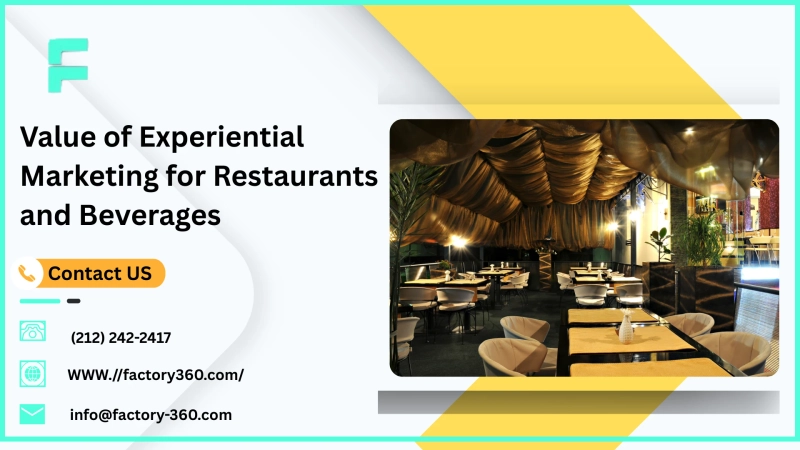As kids, we were all taught that the senses responsible for ‘experiencing’ food and drinks are the senses of vision, smell, and most importantly, taste. But when we look at those advertisements running on our flat screens or smartphones, what do we get? Just visual stimulation. This is where experiential marketing for restaurants, beverages and liquor companies takes the lead at curating an experience which goes beyond ‘seeing’ ads and caters to all five senses.
In this article, let us take a deep dive into how experiential marketing for beverages, restaurants, and liquor companies helps businesses scale effectively, as well as some helpful tactics and platforms for you to place your restaurant, beverage or liquor for maximum ROI.
What is Experiential Marketing in Practicality?
Also known as XM, experiential marketing relies on creating a fun and talk-worthy experience that allows you to connect and mingle with your audience. Such events also foster an environment where your audience tastes, smells, sees and consumes your product as they learn about your brand. These types of experiences go beyond what your customer sees from within the constraints of their screens, as they see a manifestation of your vision, story, beliefs and more.
So in a nutshell, experiential marketing for restaurants, beverages, and liquor brands is marketing beyond camera scenes, taglines, scripts and actors, where real people come in to participate and engage with what you’re putting forth.
How to Implement Experiential Marketing for Restaurants, Beverages, and Liquor Companies?
Let us start with a layman example, what excites you more: close-up HD shots of a restaurant’s ambience on your TikTok, or a Food Meet hosted in the very restaurant where you can taste and smell the food, look around and take in the lighting and decor? This is the divide between traditional marketing and experiential marketing for restaurants, beverages, and liquor companies.
The pointers below will make it clear how the food and beverage industry can use experiential marketing to amplify their consumer base while maintaining a scalable ROI of their marketing budget:
1. Exclusivity and Gourmet Tastings
Dining experiences have evolved beyond just tasting and consuming the food because who doesn’t rave on about being treated like royalty? When you channel this energy through an event that drives on being exclusive, limited, and with gourmet food and drink options, you become the preference for customers looking for an experience beyond the ordinary.
2. Food and Drink Samplings
Some brands launch samples of their beverage and alcoholic drinks before actually launching them for all. This again, gives the consumer base an ‘insider-only’ feel. This special treatment spreads word-of-mouth and creates a hype in the market even before the product is launched. This tactic is particularly helpful while carrying out experiential marketing for beverages and liquor companies.
3. Creativity Workshops
Get into the niche of your company and product to see which activity aligns best with your brand’s value, then host a workshop for the activity surrounded with your brand presence. This is exactly what Smirnoff did in their ‘Equalizing Music’ campaign, in which they addressed the gender inequality among the electronic music industry as a successful attempt at experiential marketing for liquor companies.
4. Music Festival Sponsorships
Most youth-targeting brands place themselves in an environment that offers the most visibility and practicality, which brings us to considering sponsorships for music festivals. Brands like Red Bull sponsor festivals where people need energy to give them ‘wiiiings’. This is a successful attempt of experiential marketing for beverages because instead of creating a set for their ad to be shot at, the whole festival becomes an ad location.
5. Influencer Marketing and PR Packages
Influencer marketing is one of the latest developments in the marketing arena, with social media influencers being the new celebrities. Many brands send a PR package of pre-launch products to an influencer whose content aligns with their brand values so that the influencer showcases the products and exclusive packaging to their audience. This creates an air of luxury, specialty, and desire, even before the actual product is launched.
6. Implementing AR and VR Technologies
You must’ve seen certain food or drink packaging with a QR code on it waiting to be scanned to unlock an alternate reality within the purchase experience. Most restaurants, beverage and alcohol companies use such QR codes to unlock things like a mini-game, or social media filters, or even a product catalogue. This helps brands show more of their ‘fun’ side to buyers to attract them for more such unexpected perks.
Experiential Marketing: The Newest Attempt at Making Ads Fun
In 2025, experiential marketing for restaurants, beverages, and liquor brands is taking the arena up into a whole new whirlwind by allowing potential customers to step inside the advertisement by compiling all the product principles and selling points into an event for all to come to and experience. This creates a space where word-of-mouth marketing flourishes because living and celebrating a product creates a ripple effect where attendees talk about it and popularize it.



